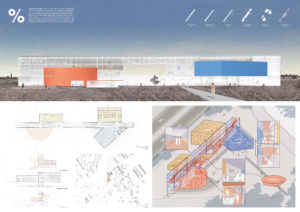Bauhaus 1919:
• Oppose the “machine age” attack on traditional crafts, while advocates the use of industrial technology to improve production efficiency
• Unity of art and technology
• Designed to respond to social needs
• Industrialized design method
Bauhaus 2021:
• Oppose the impact of the “information age” on individual thinking, while advocates the use of information technology to improve exchange efficiency
• Unity of external information resources and internal individual thinking
• Designed to respond to social needs
• Informatization design method
Design Statement:
Information has dominated our age. As the frequency of information exchange between different groups of people increases, the space will become more diverse and the connection of different spaces will become richer. In campus, the boundary between learning space, daily life space, and public activity place is gradually broken. The campus space gets rid of the parallel group education system. Different individuals and communities could choose and seek special spaces and organize his own campus life personally.
In the information age, we believe that architectural design methods should be changed. Design is based on the logic of human activities data to meet the complex and diverse needs of individuals. Function types, spatial dimensions, and spatial organization will be extracted from human behavior patterns instead of the designer’s subjective wishes. Besides, the layout
and combination of campus space can be adjusted according to the changes in the needs of participants.
In this way, we aim to build an autonomous campus that promotes the borderless exchange of various information and knowledge.
USER-ORIENTATED PROGRAM RESEARCH:
The New Bauhaus Campus emphasizes informatization: collecting personalized information and use big data to formulate the campus structure. By collecting the functional and spatial needs of different people in the campus, the campus space can be personalized based on user-orientated research.
GRID AS A CUSTOMIZED UNIT:
Based on the user-orientated research, a flexible structure is needed for personalized customization. The grid provides a free choice of lattice space.
One or several grids composed together are treated as a “dot”. These dots can be freely connected to each other, and they are in a state of free distribution on site. Customized points provide more possibilities for multiple choices, while different combination of dots enhanced the publicity and diverisity of campus.
ADJACENCY STUDY:
The adjacency between programs will create diverse interpersonal communication. By categorizing different function types and research on their relativity, the adjacency study provides a reference for spatial layout.
ITERATION OF MASTER PLAN:
According to the adjacency study, we can generate campus models with different personalities.
The traditional Bauhaus campus is oriented by functional division. In the present and near future, the information explosion will affect the knowledge acquisition and communication mode of architecture as architecture becomes more diversified and topical. So a dynamic and customized campus model based on information and data analysis will
emerge as the times require.
DYNAMIC CLUSTERS:
In this dynamic, diversified and customized Bauhaus campus based on data analysis and its changes, numerous unit modules with various functions can be continuously combined to form new themed campus clusters according to the needs of the student, who are the main body of the university. In this way, a vibrant new Bauhaus campus will be established.
Bauhaus Campus 2021
This project was awarded an Honorable Mention by the jury of the Bauhaus Campus 2021 competition. Registration ID #1584
OLG studio
Zishuo Zhang
Tongji University in CHINA
kylezzs1948
Dingwen Wu
University of Pennsylvania
legenope
Xiaohan Ren
Tongji University in CHINA
renxh57
Ziyan Ge
Tongji University in CHINA
hyen_sh
read more +


